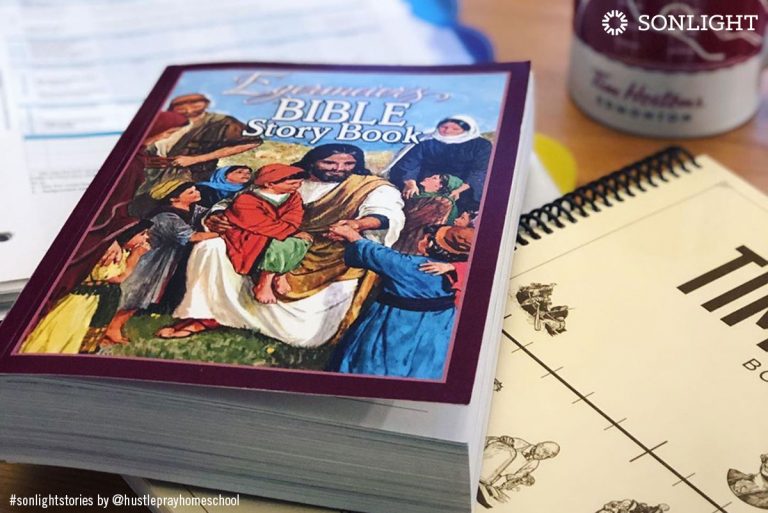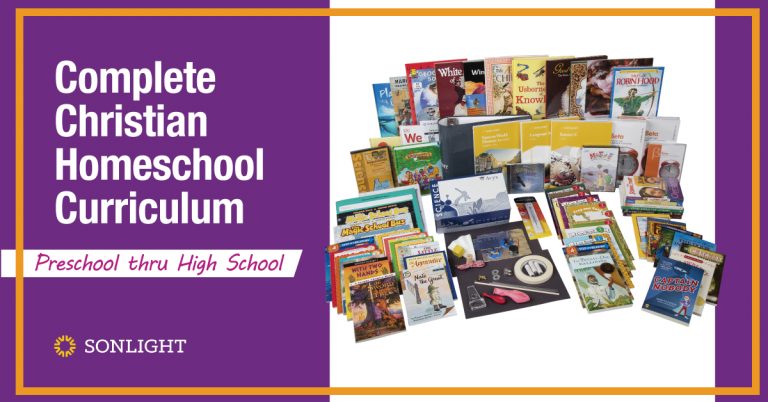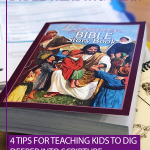The Bible reading portion in Sonlight's History / Bible / Literature programs is one of our favorite parts of the day. I particularly appreciate how the assignments are listed at the very top of the Instructor’s Guide, a simple reminder that Bible study is the most important part of our schedule.

It’s taken us a few years to grasp how to dig into the Bible reading portions, but we have hit our stride now. I’m tickled to share with you a few tips for getting the most out of your simple Sonlight Bible reading plan.
1. Use a Bible Study Notebook
Most people don’t really think about taking notes when they study the Bible, but to truly study the Bible, we need to teach our children to dig in. In your Bible study notebook, you’ll want to focus on comprehension. Answer basic questions:
- Who?
- What?
- When?
- Where?
- How?
- Why?
These questions are particularly important to ask at the beginning of a book of the Bible and help you stress the importance of reading in context. I appreciate how Sonlight generally assigns sections of the Bible rather than random, disconnected passages. The Bible should be studied in a logical order.
This is also a great time to teach your children how to outline. I love outlining the Bible. There is so much depth there to flesh out, and outlining is a great way to do that. I always suggest that parents not rush their children into note-taking. Until they are proficient at handwriting, this can easily be a shared activity. Simply use a family Bible notebook instead of individual notebooks.
You will also want to add a few reference pages to your Bible study notebooks
- a list of the Books of the Bible
- a copy of the Sonlight reading schedule
- a list of the attributes of God
2. Use Tools
I am a big believer in applying tools to help us get the most out of our Sonlight bible reading time. We use colored pencils to mark themes and big ideas. The color-coding helps us spot an attribute of God, embedded in the text. We use our colored pencils to indicate
- repeated words and phrases
- contrasting words
- sections to commit to memory
- new words to define
My girls are even known to illustrate verses in the margins of their Bible pages on occasion.
Another useful tool to have on hand is a cross-reference guide. Many Bibles include cross-references in the notes section. However, I think that having a large reference book is a helpful addition to the Christian homeschooler's library. Cross-reference guides help connect scripture to other scriptures, which can help to deepen our understanding of a passage.
Of course, a dictionary is essential when studying the Bible. Even looking up simple words can help us enrich our comprehension of the scriptures.
Another unnecessary, but helpful tool is a parallel translation Bible. Seeing two translations side-by-side can bring a deeper understanding to your Sonlight Bible reading.
3. Use Your Timeline
Yes! You should use your timeline for the Bible passages too! Record everything in your Timeline Book:
- each new book of the Bible
- all the main Bible characters
- Biblical events
It’s incredibly interesting to see where Biblical events and people fit into the larger picture of history, and the timeline book is the perfect way to illustrate that.
4. Encourage Repeated Readings
In my family, any time we study the Bible, we encourage repeated readings of a section. We try to do this in an inconspicuous way though. We always announce the passage we will be reading and then have the kids read it to themselves first. Then, one of us will read it to them. After that, we go through line by line and take apart the text for study. Usually, by the end of our family time, our kids have read or heard the scripture passage at least three times. Another good way to encourage repeated readings is to play online audio Bibles.
Please remember, the only requirement for study is to have a Bible and a heart of prayer. All these ideas are simply helpful extras when you want to dig deeper.
However, I do believe that the more we can devote to our Bible study time, the deeper our understanding of the scriptures will be. Showing our kids how to study the Bible gives them a head start, preparing them for launching into the world on their own. They will need that firm foundation that focused Bible study provides. Take heart, moms and dads, you can disciple your children, and it starts now. So grab the colored pencils and get to it!
SmoothCourse will walk you through the curriculum choosing process so you can select the best programs for your family.








